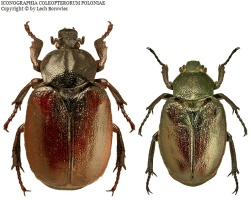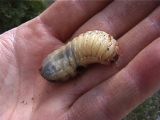Підтримуємо Вільну Україну
 We Support Free Ukraine
We Support Free Ukraine

Biodiversity Map
Taxa

Osmoderma — subordinate taxa:
Taxon count: 1
-
Arthropodaphylum
Click to switch
to select orders
and filters > -
Hexapodasubphylum
Click to switch
to select orders
and filters > -
Insectaclass
Click to switch
to select orders
and filters > -
Coleopteraorder
Click to set
as the main taxon
and as a base
← of the left panel > -
Polyphagasuborder
Click to set
as the main taxon
and as a base
← of the left panel > -
Scarabaeiformiaseries
Click to set
as the main taxon
and as a base
← of the left panel > -
Scarabaeoideasuperfamily
Click to set
as the main taxon
and as a base
← of the left panel > -
Scarabaeidaefamily
Click to set
as the main taxon
and as a base
← of the left panel > -
Cetoniinaesubfamily
Click to set
as the main taxon
and as a base
← of the left panel > -
Trichiinitribe
Click to set
as the main taxon
and as a base
← of the left panel > -
Osmodermatinasubtribe
Click to set
as the main taxon
and as a base
← of the left panel > -
Osmodermagenus
Click to set
as the main taxon
and as a base
← of the left panel >
PL
YES
name status: valid name
BioMap ID: 1013854
taxon code: 2543
taxonomy checked: YES
Polish Red Book: VU
Polish Red List: VU
Habitats Directive: Annex II, Annex IV
Data on distribution in Poland

Statistics
- Records: 126
- Publications: 76
- Collections: 11
- Publication authors: 67
- Illustrations (iconography): 1
- Photos (specimen/observation): 5
Taxon description
[d. KFP 2543: Osmoderma eremita] Gatunek występujący głównie w zachodniej, południowej i środkowej części Europy oraz sporadycznie i rzadko w południowej części Fennoskandii. Występuje na terenach nizinnych i w niższych położeniach górskich na całym obszarze Polski, ale jest stosunkowo rzadko i nielicznie poławiany. Cykl rozwojowy trwa trzy — cztery lata. Larwy żerują przeważnie w dziuplach w próchniejącym drewnie drzew liściastych, zwłaszcza wierzby lip i dębów, na pobrzeżach lasu, polanach śródleśnych, w starych alejach i przy drogach. Postacie dorosłe poławiane są zwykle pojedynczo od maja do sierpnia. Prowadzi w ciągu dnia skryty sposób życia, chroniąc się przeważnie w dziuplach, skąd wyfruwa o zmroku lub w nocy (znajdowany w wypluwkach sów).
Illustrations
... browse
 Osmoderma
Osmodermabarnabita
Photos
... browse
 Osmoderma
Osmodermabarnabita
 Osmoderma
Osmodermabarnabita
 Osmoderma
Osmodermabarnabita
 Osmoderma
Osmodermabarnabita
 Osmoderma
Osmodermabarnabita
External data sources
- Ostatnie rekordy
-
1112077
 ⊡
⊡ Scarabaeidae: Osmoderma barnabita, PL, Beskid Wschodni, Przemyśl, UTM FA21, 2016, leg. J. Mazepa
Scarabaeidae: Osmoderma barnabita, PL, Beskid Wschodni, Przemyśl, UTM FA21, 2016, leg. J. Mazepa -
1110766
 ⊡
⊡ Scarabaeidae: Osmoderma barnabita, PL, Podkarpacie, Nizina Sandomierska, Nowa Grobla ad Jarosław, UTM FA45, 1994, leg. J. Mazepa
Scarabaeidae: Osmoderma barnabita, PL, Podkarpacie, Nizina Sandomierska, Nowa Grobla ad Jarosław, UTM FA45, 1994, leg. J. Mazepa -
1110765
 ⊡
⊡ Scarabaeidae: Osmoderma barnabita, PL, Podkarpacie, Nizina Sandomierska, Ostrów ad Jarosław, UTM FA23, 2012, leg. J. Mazepa
Scarabaeidae: Osmoderma barnabita, PL, Podkarpacie, Nizina Sandomierska, Ostrów ad Jarosław, UTM FA23, 2012, leg. J. Mazepa -
1110764
 ⊡
⊡ Scarabaeidae: Osmoderma barnabita, PL, Podkarpacie, Nizina Sandomierska, Jarosław ad Jarosław, UTM FA24, 1998, leg. J. Mazepa
Scarabaeidae: Osmoderma barnabita, PL, Podkarpacie, Nizina Sandomierska, Jarosław ad Jarosław, UTM FA24, 1998, leg. J. Mazepa -
1057755
 ×
× Scarabaeidae: Osmoderma barnabita, PL, Nizina Wielkopolsko-Kujawska, Antonin ad Kalisz, 1990, leg. A. Melke
Scarabaeidae: Osmoderma barnabita, PL, Nizina Wielkopolsko-Kujawska, Antonin ad Kalisz, 1990, leg. A. Melke -
1041305
 ⊡
⊡ Scarabaeidae: Osmoderma barnabita, PL, Nizina Mazowiecka, mazowieckie, Warszawa, Warszawa, Warszawa, rez. Las Natoliński, UTM EC07, 2006, leg. D. Kucharski
Scarabaeidae: Osmoderma barnabita, PL, Nizina Mazowiecka, mazowieckie, Warszawa, Warszawa, Warszawa, rez. Las Natoliński, UTM EC07, 2006, leg. D. Kucharski -
1034898
 ⊡
⊡ Scarabaeidae: Osmoderma barnabita, PL, Nizina Sandomierska, podkarpackie, Jarosław, Jarosław m., Jarosław, UTM FA24, 2018, leg. T. Mrozek
Scarabaeidae: Osmoderma barnabita, PL, Nizina Sandomierska, podkarpackie, Jarosław, Jarosław m., Jarosław, UTM FA24, 2018, leg. T. Mrozek -
1034726
 ×
× Scarabaeidae: Osmoderma barnabita (2017f)
Scarabaeidae: Osmoderma barnabita (2017f) -
1034725
 ×
× Scarabaeidae: Osmoderma barnabita (Kadej et al. 2018b)
Scarabaeidae: Osmoderma barnabita (Kadej et al. 2018b) -
1009061
 ×
× Scarabaeidae: Osmoderma barnabita, kujawsko-pomorskie, Świecie, Osie, Tleń, 1922, coll. MiIZ PAN: Tenenbaum Sz.
Scarabaeidae: Osmoderma barnabita, kujawsko-pomorskie, Świecie, Osie, Tleń, 1922, coll. MiIZ PAN: Tenenbaum Sz. - ... more
- Powiązane publikacje
-
Kadej M., Nowak K., Pietruszewska E., Smolis A., Wolff E., Koltun M., Tarnawski D., Zając K. 2018b. Pachnica dębowa Osmoderma eremita sensu lato (Scopoli, 1763) w południowo-zachodniej części Polski - kolejne nowe dane o występowaniu i biologii gatunku. Przyroda Sudetów, 21:131-148.
 Show records
Show records -
Kadej M., Nowak K., Pietruszka E., Zając K., Regner J., Stajszczyk M., Smolis A., Tarnawski D. 2017f. Pachnica dębowa Osmoderma eremita s.l. (Scopoli, 1763) na Opolszczyźnie – aktualny obraz rozmieszczenia i perspektywy ochrony. Przyroda Sudetów, 20:127-142.
 Show records
Show records -
Komosiński K., Browarski B., Bujnik B. 2009. Inwentaryzacja entomologiczna. [In:] Studium Techniczno-Ekonomiczno-Środowiskowe. Etap I dla inwestycji polegającej na rozbudowie drogi krajowej nr 16 na odcinku Sorkwity-Mrągowo-Orzysz-Ełk - warianty dodatkowe. pp. 162-172.
 Show records
Show records -
Mokrzycki T., Byk A., Borowski J. 2008. Rzadkie i reliktowe saproksyliczne chrząszcze (Coleoptera) starych dębów Rogalińskiego Parku Krajobrazowego. Parki Nar. Rez. Przyr., 27(4):43-56.
 Show records
Show records -
Gawroński R., Oleksa A. 2007. Nowe stanowiska rzadkich i zagrożonych chrząszczy (Coleoptera) z północnej Polski. Wiad. Entomol., 26(1):5-14.
 full text
full text Show records
Show records - ... more






